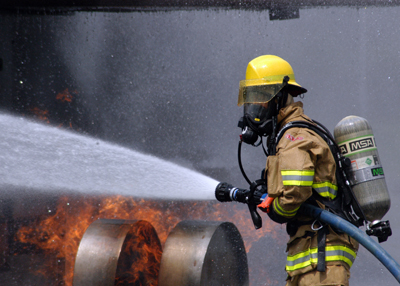Protect and Serve

At George Mason University, the Athletic Training and Public Safety Fellowship has paired certified athletic trainers with the local Prince William County Department of Fire and Rescue and Police Department. The program was built with the intent of reaching out in the county to help firefighters and police officers not only prevent injuries, but recover when they do occur.
“We’re taking the resources we have at the university, through our undergraduate and graduate programs in athletic training, kinesiology, and exercise fitness and health promotion and providing that expertise to the fire department and police,” Shane Caswell, PhD, ATC, CSCS, Professor of Athletic Training and Co-Director of the Sports Medicine and Research Training Laboratory at George Mason, said in a university press release. “I know we’re one of the only programs in the country that has set up a fellowship like this in athletic training to work with this population.”
An article from Prince William Living explains that the program was developed after Dr. Caswell worked with the Department of Fire and Rescue on several Kyle Wilson Walk for Fitness events. Wilson, a Prince William County firefighter who died in 2007, had been one of Dr. Caswell’s students.
“People who engage in public safety are really tactical athletes,” Dr. Caswell told Prince William Living. “The physical demands of their jobs often put them into positions that are not too dissimilar from injuries that you would see in an athletic environment. Rehabilitating them and helping to prevent the injuries these tactical athletes suffer is quite similar to working with sports athletes.”
Currently, there are two athletic trainers assigned to the project, and they work out of the Prince William County Public Safety Academy. The main purpose of the fellowship is to help with preventing injury through training and exercise. If an injury is sustained, the athletic trainers help to get the police officer or firefighter back to work. Common ailments seen include torn ACLs and biceps, broken bones, and rotator cuff and back injuries.
“I’m able to use a lot of my skills, and I’m able to return people to the jobs they want to do,” George Mason Athletic Trainer Jody McConnell, ATC, who works specifically with firefighters, told Prince William Living. “That’s satisfying. They’re a great group of people. They’re very motivated, and they’re obviously doing a tremendous job. Being able to get them back to something they love to do, and do well, is very satisfying.”
Costing $45,000 per year, the program saves the county in expenses from both rehabilitation and doctor’s visits. Along with keeping rehabilitation and training in-house, the benefits are reflected by keeping individuals on the job.
“The goal is to reduce time off from work and make sure people are getting back on the fire apparatus without getting reinjured.”
Frank Orefice, Prince William County Fire and Rescue Battalion Chief, told Prince William Living.
“Losing someone for months and having to backfill that position, with overtime, plus all of the medical bills — it adds up,” Orefice continued. “I’d say for every dollar we’re spending, we’re getting seven dollars back on our investment.”
The program has been in place for about a year. Dr. Caswell hopes to eventually expand it to include students, as well as a strength and conditioning element. But so far, the reviews have been nothing but positive.
“The program has exceeded my expectation,” Orefice said in a university press release. “There’s a prevention component. There’s a treatment component. There is recognizing minor injuries before they become major injuries. It’s going to be a model for other departments all around the region.”



